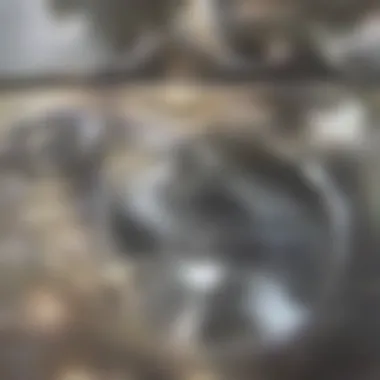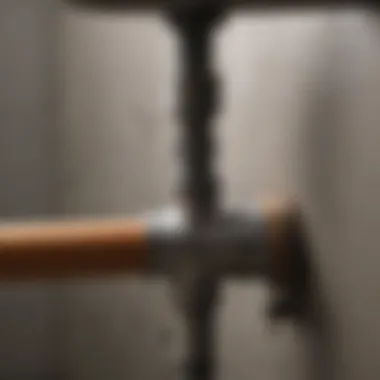Understanding U-Pipes: Functionality and Maintenance Guide


Intro
U-pipes, often overlooked, are fundamental components in the plumbing of kitchens and bathrooms. Their design is simple yet effective, making them essential for proper drainage. Understanding the intricacies of U-pipes helps homeowners maintain their plumbing systems efficiently. This guide will provide insights into these fixtures, from their basic functions to potential issues one may face.
The U-pipe, or trap, serves several purposes. It prevents the escape of sewer gases into your home, safeguards against clogs, and allows for easy maintenance. This narrative will unravel the components, common problems, and best practices for upkeep, ensuring you can take proactive steps in home maintenance.
By the end of this exploration, readers will possess the knowledge needed to troubleshoot, repair, or maintain their U-pipe systems. This is not just about plumbing; it’s about enhancing one’s understanding of home infrastructure in a practical and informative manner.
The Purpose of U-Pipes
U-pipes, often located beneath sinks, serve a critical function in plumbing and drainage systems. Understanding their purpose is essential for homeowners looking to maintain a functional and efficient drainage setup. At a basic level, U-pipes are designed to facilitate the safe movement of wastewater away from the home, while also preventing unpleasant odors from entering the living spaces.
The U-shaped configuration of these pipes enables them to trap water, creating a seal that effectively blocks gases from the sewage system. This feature is particularly important in maintaining indoor air quality. Moreover, U-pipes are integral to the overall drainage system, ensuring that sinks drain properly and that blockages are minimized.
In addition to providing odor control, U-pipes can accommodate minor changes in water flow. They flexibly adapt to shifts in pressure and temperature, which helps in preventing leaks and potential water damage. Knowing this, homeowners can appreciate that these pipes are not just functional elements but have a significant role in their plumbing systems.
Understanding Drainage Systems
To grasp the importance of U-pipes, one must first understand how drainage systems operate. Different parts of a home are connected to a network of pipes which work together to remove wastewater. If any part of this system fails, it can result in leaks or backups that compromise the integrity of the home.
In a typical drainage system, the flow of water follows gravity. U-pipes are strategically placed to manage that flow effectively. They are linked to sink drains and other fixtures, guiding wastewater toward larger sewer lines.
Being mindful of how this system works allows homeowners to identify potential issues before they escalate. Regular inspections can help detect early signs of trouble, such as slow draining or abnormal smells.
Role of the U-Pipe in Plumbing
The U-pipe has a versatile function, making it a pivotal component in plumbing. It is mainly responsible for:
- Creating a Seal: The water retained in the U-pipe serves as a barrier against harmful gases, ensuring they do not enter the home's environment.
- Facilitating Drainage: It stabilizes water flow from sinks to the main drainage system, helping prevent clogs.
- Adapting to Changes: The design of U-pipes allows them to accommodate fluctuations in pressure and temperature, contributing to overall plumbing resilience.
In summary, understanding the purpose of U-pipes is essential for maintaining efficient plumbing systems and ensuring a clean, safe living environment. Their role in preventing gas leaks and facilitating effective drainage cannot be understated. Addressing any issues with U-pipes promptly can help maintain the structural integrity of a home's plumbing.
Key Components of U-Pipes
The U-pipe is a critical element in a home's plumbing system, specifically designed to facilitate drainage and prevent foul odors from entering living spaces. Understanding the key components of U-pipes is essential for any homeowner looking to maintain an efficient plumbing system. This section delves into two primary components: the materials used in construction and the various connection points and joints. Each aspect contributes significantly to the overall functionality and durability of the U-pipe.
Materials Used in U-Pipe Construction
The materials used to construct U-pipes play a vital role in their performance and longevity. Common materials include:
- PVC (Polyvinyl Chloride): Known for their cost-effectiveness and corrosion resistance, PVC pipes are prevalent in modern plumbing systems. They are lightweight and easy to install, making them an appealing choice for many homeowners.
- ABS (Acrylonitrile Butadiene Styrene): Similar to PVC, ABS pipes are strong and durable. They are also resistant to impact and have good heat resistance but can be more expensive.
- Metal (Copper or Galvanized Steel): While less common in newer installations, metal pipes are still found in older homes. Copper is highly durable and antimicrobial, while galvanized steel is resistant to rust but can corrode over time.
Choosing the right material for U-pipes depends on various factors such as budget, installation environment, and personal preference. For example, PVC is suitable for most household applications, while metal might be necessary in specific conditions where durability is paramount.
Connection Points and Joints
Connection points and joints are crucial for ensuring a leak-free and efficient U-pipe system. Key considerations include:
- Types of Joints:
- Sealing Techniques: Proper sealing is essential to avoid leaks. Homeowners often use plumber's tape or thread sealant for threaded joints, ensuring a snug fit. Additionally, flexible rubber gaskets can provide extra protection against leaks.
- Slip Joints: These allow for adjustment during installation and are common in U-pipe setups. They require careful alignment to prevent leaks.
- Compression Joints: Offered in various sizes, these provide a secure seal and are often used where pipes meet.
- Socket Joints: The most typical joints in PVC U-pipes, allowing for easy assembly and disassembly when necessary.
Getting familiar with the connection points and joints of U-pipes can save homeowners considerable trouble down the line. Proper assembly and regular checks can help maintain a functional plumbing system and prevent substantial repair costs.


Understanding the key components of U-pipes enables homeowners to make informed decisions about their plumbing systems and enhances their ability to maintain optimal draining conditions.
Installation of U-Pipes
Installing a U-pipe under your sink is a critical part of maintaining a functional plumbing system. This installation not only secures optimal drainage but also prevents potential leaks and backups in your home. Understanding how to correctly install a U-pipe allows homeowners to ensure that their plumbing operates smoothly and efficiently. Furthermore, it reduces the risk of costly plumbing repairs in the future.
Tools Required for Installation
Before starting the installation, it is essential to gather the right tools. Here’s a concise list of tools necessary for ensuring a successful U-pipe installation:
- Adjustable Wrench: For tightening and loosening connections.
- Pipe Cutters: Useful for cutting pipe to the correct length if necessary.
- Plumber's Tape: To prevent leaks at threaded connections.
- Bucket: To catch any water that may leak during the process.
- Cleaning Cloth: For wiping any spills or excess water.
Using these tools will make the installation process smoother and more efficient. Without the right equipment, you may face unnecessary complications.
Step-by-Step Installation Process
- Gather Materials and Tools: Ensure you have the U-pipe, all necessary fittings, and the tools listed above.
- Turn Off the Water Supply: Locate your sink’s shut-off valves and turn them off. This step will prevent water from flowing while you work.
- Remove the Old U-Pipe: Use the adjustable wrench to disconnect the old U-pipe from the sink and the drainage system. Be prepared for some water to spill, so have your bucket ready.
- Inspect Connections: Clean the area where the new U-pipe will connect. Check for any signs of wear or damage in the plumbing.
- Install the New U-Pipe: Position the new U-pipe in place. Hand-tighten the connections at first, ensuring the pipe is aligned correctly.
- Secure Connections: Use the adjustable wrench to securely tighten all joints without over-tightening, which can cause damage.
- Apply Plumber's Tape: Wrap plumber's tape around threaded connections to seal any potential leaks.
- Check for Proper Alignment: Ensure everything is aligned correctly before proceeding to the next step.
- Turn on the Water Supply: Gradually turn on the shut-off valves and check for leaks. Monitor the connections as the water flows through.
- Final Check: If there are no leaks, wipe down any excess water and recheck all connections after a few hours of usage.
Following these steps will ensure that your U-pipe is installed correctly, contributing to an efficient drainage system under your sink.
Common Issues with U-Pipes
Understanding common issues with U-pipes is crucial for any homeowner. These problems can lead to significant inconvenience and costly repairs if not addressed promptly. Recognizing the potential issues can aid in maintaining your plumbing system effectively. It also allows homeowners to take measures that can prevent minor issues from escalating into bigger ones.
Clogs and Backups
Clogs are perhaps the most frequent problem faced by U-pipes. These obstructions can occur due to a buildup of food particles, grease, hair, or other debris. Over time, these materials accumulate and hinder the flow of water.
Identifying signs of a clog can be simple. If you notice that water drains slowly or makes gurgling sounds, these may be indicators of a blockage. You can attempt some DIY solutions very easily. Using a plunger or a plumbing snake can often clear minor clogs.
If you suspect a more severe buildup, consider using a mixture of baking soda and vinegar to break down the debris. This method is eco-friendly and can enhance drainage. However, beware of pouring chemical drain cleaners down your U-pipe, as they may cause damage to your plumbing over time. Regular maintenance is also key. Flushing the drains occasionally with hot water can help prevent the buildup from occurring.
Leaks and Water Damage
Another significant issue is leaks. Leaks can develop at connection points or throughout the U-pipe due to wear and tear, improper installation, or damage from external forces. To identify leaks, inspect your U-pipe for any signs of moisture or water pooling around the base. Ignoring leaks can lead to water damage, mold growth, or structural damage within your home.
If a leak is present, addressing it quickly is vital. For minor leaks, tightening connection points may resolve the issue. Applying plumber's tape can create a better seal. For more severe leaks, replacing the affected segment of the U-pipe might be necessary. Furthermore, it’s important to check for water stains on walls or ceilings below the sink, as these often indicate a hidden leak.
Taking these issues seriously can maintain the integrity of your plumbing system and enhance your home's overall condition.
Maintenance of U-Pipes
Maintaining U-pipes is a critical aspect of plumbing that ensures effective drainage and minimizes potential issues in a home. Neglecting this maintenance can lead to blockages, leaks, and other plumbing failures, which might necessitate costly repairs or extensive replacements. Thus, understanding how to properly maintain U-pipes is essential for homeowners aiming to preserve the efficiency of their plumbing systems.
Regular maintenance can significantly extend the life of U-pipes and support overall plumbing health. This involves consistent cleaning, inspection for wear, and prompt repairs when issues are detected. By being proactive, homeowners can avoid emergencies and unpleasant surprises.
Regular Cleaning Techniques
Keeping U-pipes clean is crucial for preventing clogs and ensuring smooth drainage. Several techniques can help maintain clean pipes effectively:
- Hot Water Rinse: Pour boiling water down the drain at least once a week. This helps dissolve grease and soap scum that may accumulate along the interior surfaces of the pipe.
- Vinegar and Baking Soda: A common household remedy involves using one cup of baking soda followed by one cup of vinegar. Allow it to fizz for about 30 minutes before flushing with hot water. This method can help break down minor clogs and freshen the drain.
- Mechanical Cleaners: For tougher clogs, using a plumber’s snake or auger is advisable. This tool can help remove debris lodged deeper within the pipe.
Routine cleaning not only enhances flow but also improves the longevity of U-pipes, potentially saving money in the long run.
Signs of Wear and Necessary Repairs


It is also vital to recognize early signs of wear in U-pipes. Ignoring these indicators can lead to larger, more expensive issues. Homeowners should be aware of:
- Visible Cracks or Separations: Any obvious damage can compromise the pipe's integrity.
- Unpleasant Odors: Foul smells often indicate decaying food or standing water, suggesting a blockage or leak.
- Frequent Backups: If drains are backing up regularly despite cleaning efforts, this may indicate a deeper problem that needs attention.
- Water Stains: Signs of moisture or stains near pipe connections can indicate a leak, requiring immediate repair to prevent water damage.
Addressing these issues promptly enhances the overall plumbing system and prevents further damage. Homeowners should consider regular inspections, especially in older homes, to catch any potential issues before they escalate.
Upgrading Your U-Pipe System
Upgrading your U-pipe system can enhance your plumbing’s efficiency. The right upgrades can prevent problems like clogs and leaks. U-pipes play a critical role in drainage. Thus, improving their materials and design can significantly influence overall plumbing health.
One vital consideration in upgrading your U-pipe system is selecting modern materials. Traditional materials, like metal, may corrode over time, leading to leaks. Choices like PVC and ABS plastics offer durability and corrosion resistance. They are often lighter and easier to work with during installation, making the upgrade process smoother. Additionally, these modern materials tend to have a longer lifespan than their metal counterparts.
Modern Materials and Options
Modern plumbing materials have revolutionized how U-pipes are constructed. PVC (Polyvinyl Chloride) is widely used. It is resistant to decay and easy to install. It also offers flexibility in design, allowing for various configurations that suit different plumbing needs. ABS (Acrylonitrile Butadiene Styrene) is another option, known for its strength and shock resistance.
When considering an upgrade, it is important to look at:
- Environmental Impact: Many modern materials are recyclable and contribute to sustainable plumbing solutions.
- Cost Efficiency: Although the initial investment may seem higher, the durability and lower maintenance costs often result in savings.
- Ease of Installation: Lightweight materials simplify the installation process, making DIY efforts more feasible for homeowners.
Impact on Home Drainage
Upgrading your U-pipe system can substantially affect your home’s drainage performance. Efficient drainage minimizes the risk of water pooling and sewage issues. A well-designed U-pipe can ensure that wastewater flows smoothly down the drain without obstruction.
An upgraded U-pipe can address issues such as:
- Reduced Clogs: Modern designs often feature smoother surfaces that reduce friction and minimize the buildup of debris.
- Improved Flow Rates: A correctly upgraded system can enhance the overall flow, ensuring water exits quickly.
- Long-Term Savings: Preventing plumbing issues leads to potentially lower repair costs and enhances home value.
"Investing in modern plumbing solutions not only improves functionality but can add value to your property."
Comparing U-Pipes with Other Drainage Solutions
Examining how U-pipes stack up against various drainage systems is essential to understanding the broader plumbing landscape. U-pipes are one component of plumbing solutions, and each type serves specific needs and scenarios. The nuances among these options can influence homeowner choices, especially when considering installation, maintenance, and efficiency. Exploring alternatives such as P-Traps and S-Traps helps clarify the unique attributes of U-pipes.
P-Traps and S-Traps Explained
P-Traps and S-Traps are two alternatives to U-pipes that have specific designs tailored for distinct functions.
P-Traps
- Design: This trap features a "P" shape that retains some water within, preventing sewer gases from entering the home.
- Usage: Commonly used in sink applications, P-Traps provide a reliable seal against odors while allowing smooth drainage.
- Maintenance: Cleaning is relatively easy, requiring periodic checks for clogs.
S-Traps
- Design: S-Traps take on a distinct "S" shape, primarily found in older plumbing systems. Unlike P-Traps, they require more attention to prevent siphoning.
- Usage: They are less common in modern homes due to their inefficiency but serve similar purposes as P-Traps at times, particularly in toilets.
- Maintenance: Often problematic, they are prone to losing water seals, thus necessitating more frequent inspections.
Overall, both traps serve the essential purpose of blocking sewer gases while providing drainage, but their design and efficiency can vary significantly.
Advantages and Disadvantages of U-Pipes
Understanding the pros and cons of U-pipes aids in making educational plumbing choices. Here are some key points:
Advantages


- Effective Odor Management: U-pipes effectively trap odors due to their shape and water retention, ensuring a cleaner environment under sinks.
- Simplicity of Design: With fewer parts compared to other drainage solutions, the U-pipe design simplifies installation and maintenance tasks.
- Cost-Effective: U-pipes tend to be less expensive to install than complex drainage systems, making them a popular choice among homeowners.
Disadvantages
- Size Limitations: U-pipes can be bulky in certain spaces under sinks, possibly limiting the storage of cleaning supplies and other items.
- Clogging Potential: Like any drain solution, U-pipes can be prone to clogs, requiring proactive cleaning and maintenance efforts to avoid backups.
- Material Vulnerability: Depending on the material used, U-pipes may be subject to wear over time, particularly if made from less durable substances.
In summary, while U-pipes provide an array of benefits in household drainage systems, they are not without their challenges. Understanding these intricacies equips homeowners with the knowledge needed to make informed decisions about plumbing.
The Environmental Considerations of Plumbing
Understanding how plumbing can affect the environment is essential for homeowners who care about sustainability. Plumbing systems, particularly U-pipes, play a critical role in managing water in our homes. The choices made regarding these systems can lead to significant environmental impacts.
Efficient plumbing practices lead to reductions in water waste, which is vital for preserving our natural resources. By focusing on eco-friendly materials and smart water usage, homeowners can contribute to a more sustainable future while enjoying effective drainage solutions.
Sustainable Materials in Plumbing
Utilizing sustainable materials in plumbing systems is paramount for reducing the carbon footprint. Traditional plumbing often includes metals like copper and PVC, which have environmental drawbacks in manufacturing and disposal.
Many modern alternatives are now available. For example, cross-linked polyethylene (PEX) and polypropylene (PP) are increasingly popular due to their longevity and lower environmental impact. These materials require less energy to produce and are less hazardous when they reach the end of their life cycle.
Additionally, sustainable practices also involve the sourcing of materials. Local sourcing reduces transportation emissions, ensuring a better impact on the environment. Choosing fixtures and installations made from reclaimed or recycled materials can further enhance sustainability.
Efficient Water Usage with U-Pipes
Using U-pipes efficiently is central to sustainable plumbing. These pipes are essential for preventing sewer gases from entering your home and maintaining proper drainage. However, they also contribute to overall water management.
Here are some ways U-pipes promote efficient water usage:
- Trap Design: The U-shape retains a small amount of water, creating a barrier that prevents odors and contaminants from escaping. This can encourage homeowners to avoid unnecessary water wastage.
- Leak Prevention: Proper installation and maintenance of U-pipes can prevent leaks, which not only waste water but also create the risk of water damage and mold.
- Reducing Chemical Drain Cleaners: By ensuring U-pipes are clear and functioning, homeowners can minimize the need for harsh chemical cleaners that can harm the environment.
"Efficient plumbing not only benefits your household but also the larger environment. Every drop counts."
Expert Tips for Homeowners
Understanding the nuances of U-pipes is not only beneficial but can also save homeowners from unnecessary expenses and plumbing emergencies. The role of the U-pipe in your drainage system should not be underestimated. Over time, various issues can arise, making it essential for homeowners to be proactive in their approach to maintenance. These expert tips will illuminate how small preventative measures can significantly enhance the longevity and functionality of U-pipes.
DIY Maintenance Recommendations
Regular maintenance of U-pipes is crucial in preventing clogs and potential leaks. Homeowners can easily undertake several maintenance tasks to keep their plumbing in optimal condition. Here are some practical suggestions:
- Run Hot Water: Periodically flushing your U-pipe with hot water can help dissolve grease and debris that may accumulate over time.
- Use Baking Soda and Vinegar: This natural mixture is effective in clearing minor clogs and neutralizing odors. Simply pour half a cup of baking soda followed by half a cup of vinegar down the drain. After it fizzes, flush with hot water after 30 minutes.
- Check for Signs of Wear: Regularly inspecting the U-pipe for visible issues, such as cracks or loose joints, can help identify problems early. Changing the pipe if it shows serious signs of wear will prevent more severe damage.
When to Call a Professional
While DIY maintenance is essential, some situations warrant professional intervention. Homeowners should not hesitate to call a plumber in these scenarios:
- Persistent Clogs: If clogs recur frequently despite regular maintenance, this may indicate a deeper issue within the plumbing system.
- Visible Damage: Noticing leaking near the U-pipe or any unusual moisture can signal a serious plumbing fault. It's important to address these right away to minimize damage.
- Unpleasant Odors: If bad smells persist even after cleaning the U-pipe, there could be a blockage that requires expert tools for removal.
"An ounce of prevention is worth a pound of cure. Regular maintenance can help prevent costly repairs later on."
Keeping a close check on the U-pipe system can save homeowners time and money. Being informed about routine maintenance and when to reach out for professional help aids in preserving an efficient plumbing system.
Culmination
Understanding the role of U-pipes under your sink is essential for maintaining a functioning plumbing system. Throughout this article, we examined various aspects of U-pipes, including their components, installation, and maintenance. These insights are particularly beneficial for homeowners who want to avoid costly repairs and service interruptions.
Recap of Key Points
The main points discussed in this article include:
- Purpose and Function of U-Pipes: U-pipes play a critical role in drainage systems by providing a water trap that prevents sewer gases from entering the home.
- Components: Key elements include the body, connection points, and materials used, which can affect durability and reliability.
- Installation Guidelines: Knowing the tools and the step-by-step installation process helps in undertaking repairs or upgrades effectively.
- Common Issues and Solutions: Awareness of problems like clogs and leaks, alongside maintenance practices, keeps plumbing systems functional for longer.
- Upgrading Options: Modern materials and methods for U-pipes offer sustainable and efficient solutions, improving overall home drainage.
- Environmental Considerations: The use of sustainable materials and efficient water usage practices has a positive impact on plumbing systems and the environment.
- Maintenance Recommendations: Regular checks and knowing when to call a professional are crucial for effective home maintenance.







